~JOHN HODANY/HOLY ROLLERS
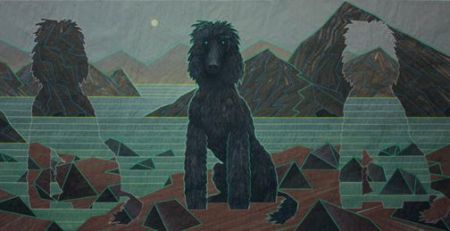
JOHN HODANY, ‘HOLY ROLLERS’, 2009. acrylic on paper inlay, 90 x 180 cm.
but, if you are in BERLIN !! – you can still catch:
JOHN HODANY – ‘HOLY ROLLERS’
MARCH 21 – APRIL 25, 2009
GALERIE LENA BRUNING – ALMSTADTSTRASSE 50 – BERLIN, GERMANY
the gallery has an amazing selection of photos from the show on their website: check here !!
including:
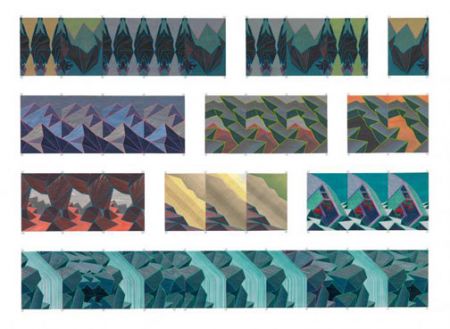
JOHN HODANY, ‘Echoe Location’, 2008, acrylic on paper inlay. 30 x 62 cm.
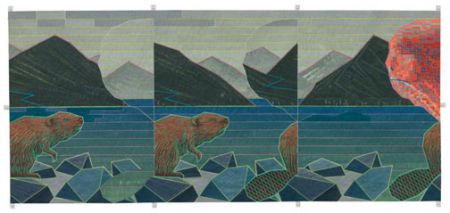
JOHN HODANY, ‘Yer Last Beaver’, 2008, acrylic on paper inlay. 60 x 136 cm.
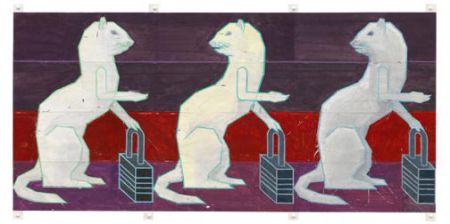
JOHN HODANY, ‘Three Weazel Study’, 2008, acrylic on paper inlay. 60 x 136 cm.
it’s interesting to see the echoes & visual evolution onto paper – from the major installation sculpture JOHN HODANY exhibited last year, (FEB 19-MARCH 16, 2008), at ELEVEN RIVINGTON, here in NYC, on the Lower East Side.
its also funny to note that the ELEVEN RIVINGTON show of last year – a large 3-Dimensional piece – (see below) – as compared to this year’s many paper renderings – went from a (working !!) complex arcade-type game – and, which struck one as very non-humanistic and purely ‘machine-like’ – ‘abstract’ and ‘objective’ – to these drawings, which though again – very ‘plastic’, very abstract in their composition – are actual animals and their habitat landscapes – sinister, or deep, mysterious, and ancient – maybe the better words are – animal totems depicted in a civilization twilight ?
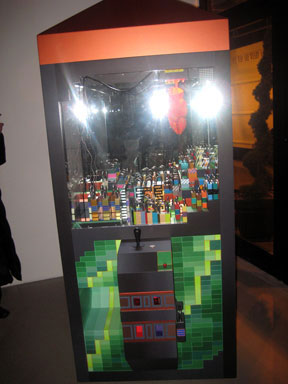
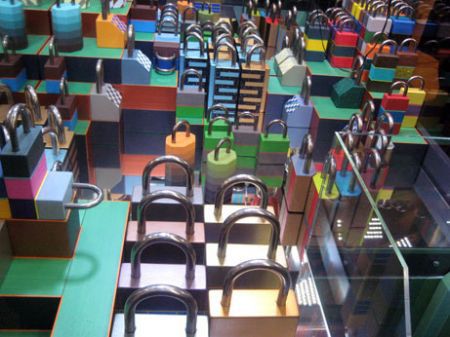
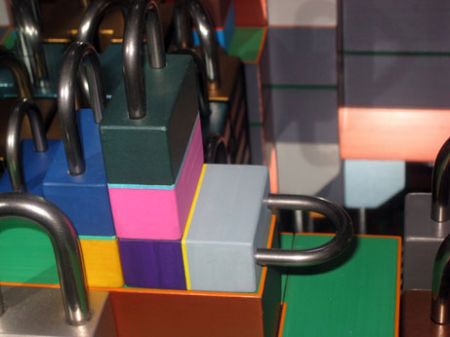
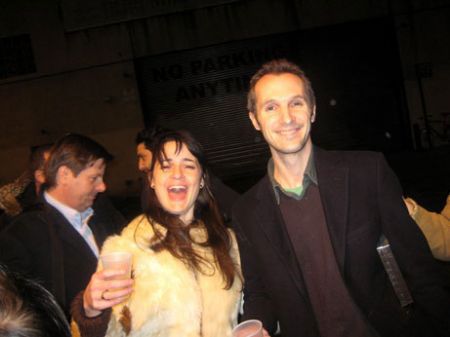
JOHN HODANY, (with ANNA CONWAY) at the ELEVEN RIVINGTON opening, Feb 19, 2008.
PHOTOS: NANCY SMITH
see: more pix from that show !!
. . . the current show at GALERIE LENA BRUNING has posted a really interesting PRESS RELEASE/ESSAY on JOHN HOANY’S work.
“The oldest known paintings on earth are thought to be over 30,000 years old. Painted or drawn depictions of horses, hyenas, rhinos, lions, bison, some half-humans and also some extinct ones cover walls in ancient caves like Chauvet and Lascaux in France. No one knows exactly why they exist. Over 600 depictions of animals appear in the Lascaux cave alone.
Strangely, neither the landscape nor any vegetation is portrayed on the walls. Maybe the artists were storytelling, explaining themselves through pictures. Perhaps there were superstitions about animals and creating images of them was thought to bring good luck. Looking through the entire history of art, you have to wonder what it is about the relationship between animals and people that provokes these mysterious works? Are the homages? Are they symbols, or stand-ins of our own bodies and selves, our own mortality or even our spirituality as the Egyptians imply?”
it also goes on to state that: “John Hodany’s body of work contains many animals. Hodany has been preoccupied with depicting the faces and bodies of creatures for over a decade. Some of his paintings, drawings and sculptures represent animals in a manner reminiscent of the Egpytian drawings of animals: there is a bold simplicity of their form that gives them an appearance of a sign or a symbol. Sometimes the animals appear in such uniform abundance that theytake on a quilt, tapestry, or ven computer-like pattern.” . . . .
“‘Holly Roller’ (the title of the show and one of the paintings) is an American term used to describe Pentecostal Christians who it was said would literally roll on the ground when possessed with the spirit of God. Nowadays the term is often used as an expression of astonishment about strange or abnormal behavior in general.”
“There i almost always a quiet, possibly even apocalyptic atmosphere in Hodany’s work that hints at a shift in world order. Where are the humans? Why are the rocks, animals, and objects organizing themselves into patterns, disappearing and reappearing as fragments within the same work? . . . (and,) Using a self-invented method, Hodany cuts into the painted surface, carefully removing pieces of his paintings and attaches them to other ares within the same work on paper. This creates a ghost-like impression in which the trace of the image that has been cut and replaced seems to imprint on the background. The fractal nature of his repeated images echo the concept of ‘cutting and pasting’ computer software style, however never losing a tactile sensibility.”
